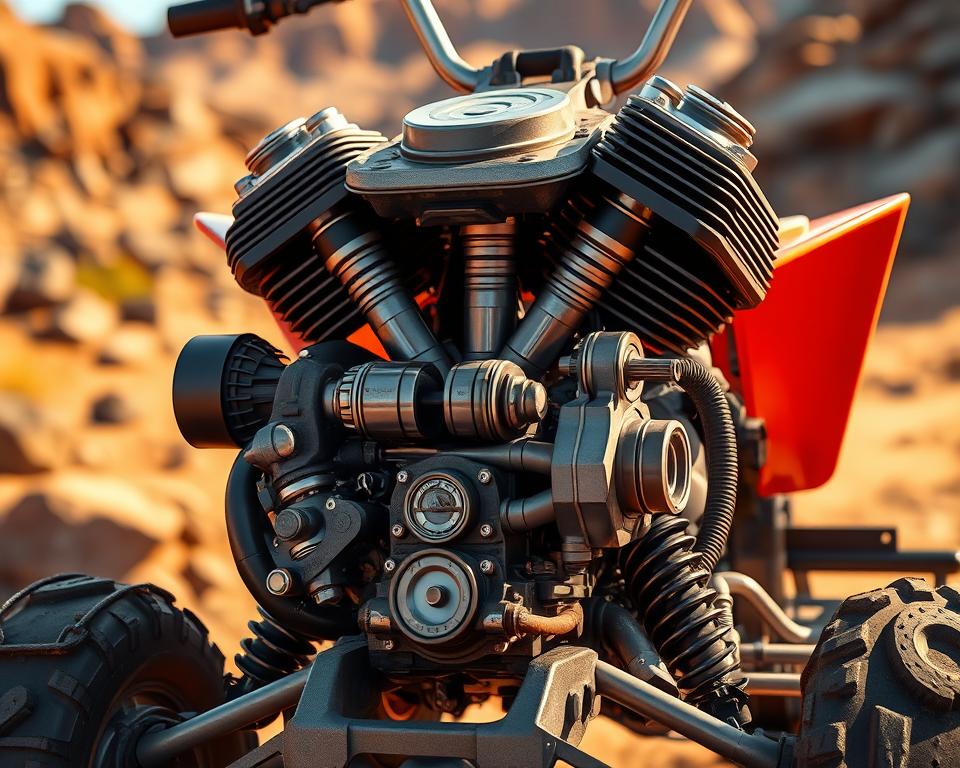Essential ATV Off-Road Checklist for Safe Riding
You might be surprised to learn nearly around 450,000 ATV-related injuries are treated in U.S. emergency rooms each year? That startling statistic underscores why off-road safety and preparation are essential. The Essential ATV Off-Road Checklist is your guide to a safe and enjoyable ride. From boulder-strewn tracks to shifting sands—it’s got you covered. Armed with proper safety equipment and maverick x3 windshield with wiper must-haves, you’ll reduce hazards and amplify the fun.
Summary Highlights
- Prioritize safety by using the Essential ATV Off-Road Checklist for optimal preparation.
- Your gear list is critical for staying protected off-road.
- Maintenance matters: check often, ride better.
- Stay fueled and hydrated for peak performance.
- Learn to use navigation tools to avoid getting lost on off-road routes.
- Be ready for unexpected weather changes to stay comfortable during your adventure.
- Trailside fixes? Have your toolkit and recovery gear ready.
Understanding the Importance of Safety Gear
When you ride off-road, safety must come first. ATVs deliver thrills—and risks. Safety gear is essential for protecting riders from accidents and injuries. A full gear check means a safer outing.

Essential Protective Gear
Maximizing protection involves several key items:
- Riding Helmets: Choose DOT-approved helmets to prevent head injuries.
- Goggles: Block dirt and grit with quality goggles.
- Gloves: Wear durable gloves for better grip and hand protection.
- Boots: Wear sturdy boots that cover the ankles to prevent injuries.
- Protective Armor: Aggressive riders should consider body armor for extra security.
- Neck Protection: A neck brace protects your spine in a crash.
Emergency Preparedness
Don’t overlook your emergency kit. A well-packed kit might save your life. Key items to include are:
- First aid kit
- Multi-tool
- Tire repair kits
- Portable air compressors
- Emergency blankets
- Whistles
- Matches
ATV Equipment for Optimal Performance
The right kit makes all the difference. Pack these essentials for any trail. Routine checks keep your ATV working its best.
Must-Have ATV Equipment
- Durable Tires: Terrain-specific tires keep you glued to the track.
- Storage Solutions: Mount racks or bags to carry your gear safely.
- Fuel Reservoir: Never run low—use a proven fuel tank.
- First Aid Kit: Prepare for emergencies with a well-stocked first aid kit for immediate attention if needed.
Regular Maintenance for Longevity
Routine care keeps breakdowns at bay. Regular inspections should encompass:
- Inspect and clean or replace air filters regularly.
- A well-lubed chain spins quietly and reliably.
- Ensure pads and discs are in prime condition.
Stay on top of upkeep and your ATV will perform its best.
The Essential ATV Off-Road Checklist
Good prep keeps surprise breakdowns away. Use this pre-ride checklist to avert trouble before it starts. Each pre-ride inspection step requires attention to detail. A little prep goes a long way.
Pre-Ride Inspection Basics
Never ride without a quick systems check. Catch faults early with a fast inspection. Key elements to check include:
- Tire pressure and tread condition
- Fluid levels such as oil and fuel
- Brakes and controls functionality
- Operational lights and horn
- Chain or driveshaft integrity
T-CLOC Inspection Method
Use T-CLOC for a thorough pre-ride check. Five key areas: T-CLOC ensures all are inspected. This method ensures all critical areas are covered:
| Inspection Area | Checklist Items |
|---|---|
| Tires and Wheels | Check tire pressure, inspect tread depth, look for damage |
| Controls | Test brakes, throttle, and clutch for smooth operation |
| Lights | Ensure headlights, brake lights, and indicators are functioning |
| Oil and Fuel | Check oil level, inspect for leaks, and fill fuel tank |
| Chain/Driveshaft | Examine for wear, proper tension, and lubrication |
Spending a few minutes on this ATV maintenance checklist can make rides safer and more enjoyable. Prevent roadside repairs with a fast check.
Hydration and Nutrition for Long Rides
Long ATV rides require careful attention to hydration and nutrition. Riders often underestimate their fluid needs, making it essential to plan ahead. Carry extra water to prevent fatigue and keep energy levels up during the adventure. The right snacks are also key for maintaining stamina on the trail.
Importance of Staying Hydrated
Dehydration leads to poor decisions and slow reflexes. Sipping regularly prevents performance drops. Backpack reservoirs keep water flowing hands-free.
High-Energy Snacks to Pack
Good snacks keep you sharp and energized. Pack portable, long-shelf treats. Some ideal choices include:
- Protein bars
- Nut mixes
- Dried fruits
- Beef jerky
Snack smart for sustained energy. Mix sweet and salty options for flavor and function.
Navigation Tools for Off-Roading Adventures
Stay on course with proven navigation aids. A dependable nav setup means you’ll always find your way.
Advanced GPS Systems
An advanced GPS system is a must for off-road adventures. Look for features like offline maps and a long-lasting battery. Garmin, TomTom, and others make GPS units built for bumps and dust.
Traditional Navigation Aids
Don’t ditch old-school compasses and maps. Waterproof maps and compasses are vital backups when your GPS fails. Knowing how to use these tools is critical, adding security to your excursions. Blend modern and classic for ultimate wayfinding.
Communication Equipment for Safety
When phones fail, two-way radios deliver. Communication gear is as critical as your helmet. It gives riders peace of mind.
For seamless communication among group members, a quality two-way radio is highly recommended. These devices ensure clear audio over long distances. Stay informed of detours or emergencies instantly. When choosing two-way radios, look for models with:
- Rugged, waterproof design to resist the elements
- Long battery life for extended trips without needing a recharge
- Channel selection for clear communication without interference
No ride is complete without radios. They keep everyone coordinated and secure. When reception is zero, your radio still works. With the right tools, your off-road trips will be smoother and more enjoyable.
Self-Rescue Gear for ATV Riders
Self-rescue gear is as vital as your helmet. Self-rescue gear for ATVs is key to handling challenges on your own. A well-prepared rider not only improves their experience but also boosts safety for all.
Winches and Recovery Kits
Winches are vital for self-rescue, helping pull your ATV from tough spots. Kit up your winch for maximum extraction muscle. Recovery kits usually include:
- Tow straps
- D-rings
- Recovery boards
- Gloves
Practice recovery techniques before you need them. With quality ATV recovery kits, you can overcome mud, rocks, or other obstacles and continue your journey.
Trail Recovery Essentials
Winches are just the start; several trail recovery essentials are also critical for off-road adventures. These include:
| Equipment | Purpose |
|---|---|
| Recovery Straps | Used for towing or pulling ATVs out of tight situations. |
| Shovel | Helps clear obstacles and dig out vehicles when stuck. |
| Traction Mats | Provides grip under tires in muddy or slick conditions. |
| Portable Air Compressor | Enables quick tire inflation after deflating for better traction. |
Arming your ATV with the right self-rescue gear ensures you can handle any obstacles. Knowing how to use these tools greatly improves safety and adventure on your off-road excursions.
Staying Adaptable: Preparing for Weather Changes
Expect the unexpected in the outdoors. Your comfort and safety depend on proper weather prep. Don’t forget your layers and rain shell.
Dress in layers to stay comfortable. Start with wick-away fabrics. Fleece or wool gives you warmth on demand. Finish with a rain-and-wind jacket. This setup ensures you stay comfortable, no matter the weather.
Weather-Appropriate Clothing
- Waterproof Jackets: Stay dry when the sky opens up.
- Ventilated Off-Road Pants: Allows for ventilation while protecting against wet conditions.
- Sun Protection: Shield skin from sunburn with proper apparel.
- Cold-Weather Gloves: Insulate your hands against cold snaps.
Gear up for every climate challenge. It keeps you comfortable and safe, letting you enjoy the adventure without worrying about the weather.
Tools for On-Trail Repairs
Having the right tools for on-trail repairs is key to a safe and enjoyable off-roading experience. Don’t skimp on repair gear. Fix flats and loose bolts in minutes.
Must-Have Tools and Kits
No ride is complete without a toolkit. This kit should include essential items for quick repairs. Critical ATV repair tools might include:
- Tire irons for changing flat tires
- Pliers for gripping and cutting
- Wrenches for various sizes of bolts and nuts
- A multi-tool for versatility
- Spare items such as spark plugs and electrical wire
- Duct tape for quick fixes
Having these tools readily available boosts confidence and autonomy while exploring off-road trails.
Basic Emergency Supplies
In addition to essential tools, packing basic emergency supplies for ATV is vital. These supplies help ensure your safety in challenging situations:
- First aid kit for injuries
- Flashlight with extra batteries for night-time visibility
- Emergency whistle for signaling assistance
- Reflective triangles or flares to warn other riders
- Water and high-energy snacks for sustenance
Preparedness significantly impacts your off-roading experience. Never leave home without them.
Final Thoughts
Well-planned rides are the best rides. Follow this checklist and choose quality gear. This ensures you’re ready for any terrain.
With the right protective gear, navigation tools, and communication equipment, you’re set for safe riding. Plan smart to ride hard and safe. Focus on fun, not fears.
Be prepared, ride safe, and make great memories. Every leg of the trip matters. Check this list, then conquer nature.
FAQ
What must an ATV safety checklist cover?
Your ATV safety gear checklist should include a DOT-approved helmet and goggles. Don’t skip gloves, boots, and armor. Neck braces offer additional protection. Remember to pack an emergency kit with a first aid kit and multi-tools for preparedness.
How do I keep my ATV in top shape?
To maintain your ATV, regularly check air filters and lubricate the chain. Inspect brakes as well. A consistent maintenance routine extends your machine’s life and keeps it ready for off-road adventures.
What does the T-CLOC inspection method entail?
T-CLOC is a five-step pre-ride routine. Tires, Controls, Lights, Oil, and Chain are checked in T-CLOC. Using T-CLOC guarantees safe, smooth rides.
Recommended hydration levels for trail rides?
Overestimate your water needs. Stay topped off to avoid dehydration. Hydro packs let you drink without stopping.
Must-have navigation tools for ATV trips?
Get a durable GPS with offline maps. Combine this with traditional aids like waterproof maps and compasses.
Why is communication important when off-roading?
Radios prevent isolation when cell fails. In no-signal zones, radios shine.
What self-rescue gear should every ATV rider carry?
Every ATV rider should carry a winch and a detailed recovery kit. This kit should include tow straps, D-rings, and recovery boards.
How can I prepare for sudden weather changes while off-roading?
Use a base, mid, and shell layering system. Pack a rain shell to stay dry. Don’t forget sunscreen and UV-blocking apparel.
Which trailside tools matter most?
For on-trail repairs, pack a basic tool kit for minor fixes. Include tire irons, pliers, wrenches, a multi-tool, and spare parts like a spark plug.


